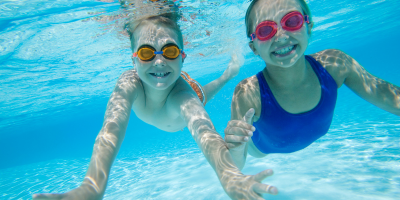
Heads Up Parents! How to Decrease the Risk of Drowning During the Summer Season
By Theresa Covell, Assistant Public Health Nurse

This past February, my family and I had the good fortune of visiting Nana and Papa and their neighborhood pool in Florida. My best friend from childhood who was once a competitive collegiate swimmer and remains an avid swimmer as an adult, was visiting with her son. While the kids swam and splashed, we sat at the edge of the pool, legs dangling in the water, catching up. We began chatting with another family as their kids entered the pool. A few moments later an older adult lounging poolside sprung up, bent down at the edge of the pool and grabbed a young boy who was submerged. He had entered the pool slowly, one step at a time. When he took the final step down into the pool, the water was over his head. He stood there, unable to move, with his mouth and nose underwater. There was no sound, no splashing, no screams for help. Five parents were there, attentively watching our kids, but not one of us noticed the young boy’s head was under water. He was ok, but I felt disbelief, and then shame…how could this happen a few feet away without us noticing?
I had incorrectly imagined a commotion: hands waving, calls for help, and splashing. Learning about the reality of what drowning looks like stuck with me, yet I still had much to learn. According to the Centers for Disease Control (CDC), 4,000 people die from drowning in the U.S every year, which equates to an average of 11 people who drown daily. It’s the leading cause of death among children between one and four years of age.
Drowning is a major public health problem and it’s completely preventable.
Who is at risk of drowning?
Anyone can die from drowning anytime there is access to water, even if they know how to swim. Certain populations are at higher risk of dying by drowning: infants, toddlers, teens (especially male teens), people with certain medical conditions like epilepsy and autism spectrum disorder, and people from socioeconomic groups with limited access to basic swimming and water safety training.
Socioeconomic Factors, Race, and Disabilities Impact Drowning Rates
Deaths among persons with autism spectrum disorder were nearly 40x as likely to be caused by drowning as deaths in the general population. Children with special health care needs should have tailored anticipatory guidance related to drowning risks. For any age group and ability, consider the effects of medications and how they may impair a person’s ability to safely be in water.
Significant racial and socioeconomic disparities exist in drowning rates among children. For people younger than age 30, drowning rates among Black people were 1.5x higher than white people. Socioeconomic barriers to achieving basic water competency include cost, limited access to quality programs, and transportation. Compounding the challenge is decreased municipal funding for swimming pools, swimming programs, and lifeguards.
Increased access to programs that develop water-competency skills for all children, especially those from low-income and diverse families and those with developmental disabilities, will help improve equity.
How to Prevent Drowning
- Teach children to always ask permission to go near water.
- Know that swimming lessons provide one layer of protection from drowning; they do not “drown proof” a child.
- Closely, constantly, and attentively supervise children when they are in and around water. Inadequate supervision is often cited as a contributing factor for childhood drowning, especially for younger children. Cell phone use, reading, conversing, and consuming alcohol or drugs impairs supervision.
- Clearly communicate which adult is responsible for each child. In a large group setting, even in the presence of a lifeguard, each young child should have a designated adult within arm’s length who is focused on supervising that child.
- Parents, caregivers, pool owners, and even older children should learn CPR and keep a telephone and rescue equipment approved by the U.S. Coast Guard (e.g., life buoys, life jackets, and a reach tool such as a shepherd’s crook) waterside.
- When visiting a new home, check the premises for potential water hazards and formulate a plan for supervision of children. Ensure barriers are in place to prevent unintended access of children to water during non-swim times. A mom who lost a young son to drowning, shares this message, “We did it. We did everything we knew to do right. How did I not know how often drowning occurs during a non-swim time?” The Consumer Product Safety Commission (CPSC) found that 69% of children younger than 5 years of age were not expected to be at or in the pool at the time of a drowning incident. Barriers are critical in preventing access to water during non-swim times.
Adolescents (15-19 Years) Have the 2nd Highest Drowning Rate
Adolescent deaths from drowning account for half of childhood drownings in natural water. Why? Because teens can easily overestimate water skills, underestimate dangerous situations, and engage in high-risk and impulsive behaviors such as jumping or diving without being aware of underwater hazards. Parents and children should be aware of water depth and physical hazards before being permitted to jump or dive. Further, parents should teach their teens to know the importance of not swimming alone, to always go in the water feet first, to wear a life vest when boating, to learn CPR, and to avoid alcohol and drugs when swimming or boating.
Do you know the Red Cross chain of drowning survival?
- Recognize the signs of someone in trouble and shout for help.
- Rescue and remove the person from the water (without putting yourself in danger).
- Ask someone to call emergency medical services (EMS).
- If alone, give 2 minutes of care, then call EMS.
- Begin rescue breathing and CPR.
- Use an AED if available and transfer care to advanced life support.

Resources
Drowning Prevention Campaign Toolkit (aap.org)
https://www.aap.org/en/news-room/campaigns-and-toolkits/drowning-prevention/
Prevention | Drowning Prevention | CDC
https://www.cdc.gov/drowning/prevention/index.html
https://downloads.aap.org/DOPA/Drowning-Prevention/water_safety_for_teens_english.pdf
Water Safety for Teens – HealthyChildren.org
Drowning Prevention for Curious Toddlers: What Parents Need to Know – HealthyChildren.org
Drowning Prevention and Water Safety (aap.org)
Prevention of Drowning | Pediatrics | American Academy of Pediatrics (aap.org)



